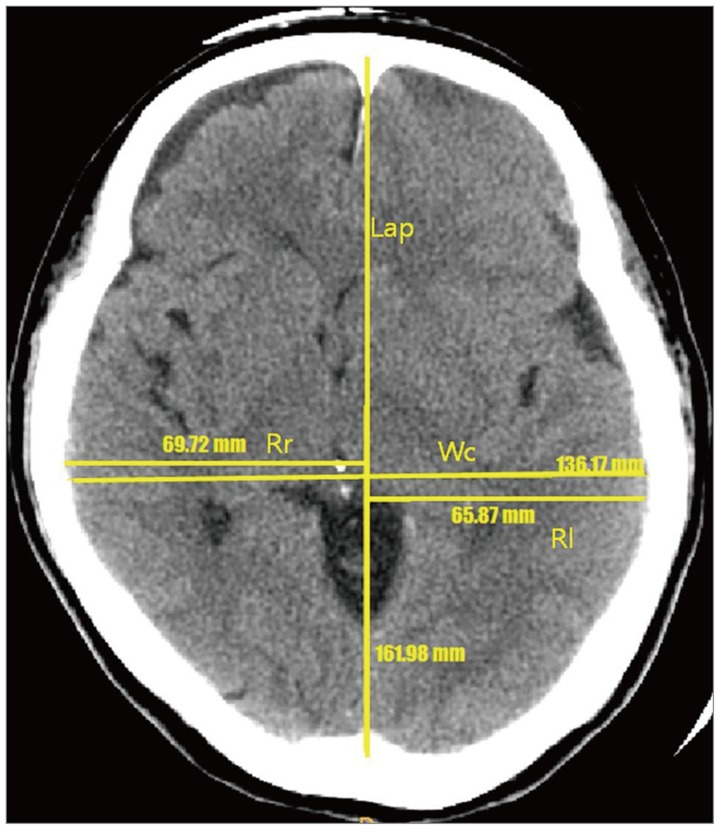Korean J Neurotrauma.
2014 Oct;10(2):82-85. 10.13004/kjnt.2014.10.2.82.
Influence of Gender on Occurrence of Chronic Subdural Hematoma; Is It an Effect of Cranial Asymmetry?
- Affiliations
-
- 1Department of Neurosurgery, Soonchunhyang University Cheonan Hospital, Cheonan, Korea. ksleens@sch.ac.kr
- KMID: 2256237
- DOI: http://doi.org/10.13004/kjnt.2014.10.2.82
Abstract
OBJECTIVE
Chronic subdural hematoma (CSDH) is a condition mostly present in older people. Men are more commonly affected than women. Several theories about male predominance could not enough to explain the reason for male predominance on CSDH. The purpose of this study is to find out whether there were any differences in the anatomy of cranium, which may contribute the pathogenesis or risk factors of CSDH.
METHODS
The study population was consisted of 87 patients with CSDH and 100 patients with transient ischemic attack (TIA) from 2006 to 2013. We classified into four groups; group A (CSDH male 47), group B (CSDH female 40), group C (TIA male 50), and group D (TIA female 50). We measured the size of the cranium in the computed tomography scans, retrospectively. We define the difference of cranium (Dc), which is difference between the right and left radiuses.
RESULTS
The Dc was significantly higher in patients with CSDH (group A and B)(p=0.03). The mean Dc was 3.49 mm in CSDH group (group A and B) and 2.14 mm in TIA group (group C and D). The mean Dc of CSDH group was significantly larger than that of TIA group (by t-test, p<0.01).
CONCLUSION
Size and asymmetry of the cranium may be a risk factor of CSDH. Gender differences in the anatomy of cranium may contribute pathogenesis of CSDH.
MeSH Terms
Figure
Cited by 2 articles
-
Letter to the Editor: Influence of Gender on Occurrence of Chronic Subdural Hematoma; Is It an Effect of Cranial Asymmetry? (
Korean J Neurotrauma 2014;10:82–85)
Laurence Marshman
Korean J Neurotrauma. 2019;15(2):239-240. doi: 10.13004/kjnt.2019.15.e37.Clinical Characteristics and Current Managements for Patients with Chronic Subdural Hematoma : A Retrospective Multicenter Pilot Study in the Republic of Korea
Hyuk-Jin Oh, Youngbeom Seo, Yoon-Hee Choo, Young Il Kim, Kyung Hwan Kim, Sae Min Kwon, Min Ho Lee, Kyuha Chong
J Korean Neurosurg Soc. 2022;65(2):255-268. doi: 10.3340/jkns.2021.0138.
Reference
-
1. Baechli H, Nordmann A, Bucher HC, Gratzl O. Demographics and prevalent risk factors of chronic subdural haematoma: results of a large single-center cohort study. Neurosurg Rev. 2004; 27:263–266. PMID: 15148652.
Article2. Beatty RA. Subdural haematomas in the elderly: experience with treatment by trephine craniotomy and not closing the dura or replacing the bone plate. Br J Neurosurg. 1999; 13:60–64. PMID: 10492687.
Article3. Chen JC, Levy ML. Causes, epidemiology, and risk factors of chronic subdural hematoma. Neurosurg Clin N Am. 2000; 11:399–406. PMID: 10918008.
Article4. Coffey CE, Lucke JF, Saxton JA, Ratcliff G, Unitas LJ, Billig B, et al. Sex differences in brain aging: a quantitative magnetic resonance imaging study. Arch Neurol. 1998; 55:169–179. PMID: 9482358.5. Cowell PE, Allen LS, Zalatimo NS, Denenberg VH. A developmental study of sex and age interactions in the human corpus callosum. Brain Res Dev Brain Res. 1992; 66:187–192. PMID: 1606684.
Article6. Ficker-Terill C, Flippo K, Antoinette T, Braunling-McMorrow D. Overview of brain injury. In : Lash M, McMorrow DB, Tyler J, Antoinette T, editors. Training manual for certified brain injury specialists (CBIS): Level 1 core competencies. McLean, VA: American Academy for the Certification of Brain Injury Specialists, Brain Injury Association of America;2004.7. Giuffrè R, Palma E, Liccardo G, Sciarra F, Pastore FS, Concolino G. Sex steroid hormones in the pathogenesis of chronic subdural haematoma. Neurochirurgia (Stuttg). 1992; 35:103–107. PMID: 1508287.
Article8. Gur RC, Gunning-Dixon FM, Turetsky BI, Bilker WB, Gur RE. Brain region and sex differences in age association with brain volume: a quantitative MRI study of healthy young adults. Am J Geriatr Psychiatry. 2002; 10:72–80. PMID: 11790637.
Article9. Haines DE, Harkey HL, al-Mefty O. The "subdural" space: a new look at an outdated concept. Neurosurgery. 1993; 32:111–120. PMID: 8421539.10. Kanat A, Kayaci S, Yazar U, Kazdal H, Terzi Y. Chronic subdural hematoma in adults: why does it occur more often in males than females? Influence of patient's sexual gender on occurrence. J Neurosurg Sci. 2010; 54:99–103. PMID: 21423076.11. Kim SG, Yang JC, Kim TW, Park KH. Factors that influence to chronic subdural hematoma recurrence. Korean J Neurotrauma. 2013; 9:81–86.
Article12. Laffey PA, Peyster RG, Nathan R, Haskin ME, McGinley JA. Computed tomography and aging: results in a normal elderly population. Neuroradiology. 1984; 26:273–278. PMID: 6462433.
Article13. Misra M, Salazar JL, Bloom DM. Subdural-peritoneal shunt: treatment for bilateral chronic subdural hematoma. Surg Neurol. 1996; 46:378–383. PMID: 8876720.
Article14. Park SH, Kang DH, Park J, Hwang JH, Hwang SK, Sung JK, et al. Fibrinogen and D-dimer analysis of chronic subdural hematomas and computed tomography findings: a prospective study. Clin Neurol Neurosurg. 2011; 113:272–276. PMID: 21156338.
Article15. Sousa EB, Brandão LF, Tavares CB, Borges IB, Neto NG, Kessler IM. Epidemiological characteristics of 778 patients who underwent surgical drainage of chronic subdural hematomas in Brasília, Brazil. BMC Surg. 2013; 13:5. PMID: 23452673.
Article
- Full Text Links
- Actions
-
Cited
- CITED
-
- Close
- Share
- Similar articles
-
- Authors' Reply to Letter to the Editor: Influence of Gender on Occurrence of Chronic Subdural Hematoma; Is It an Effect of Cranial Asymmetry? (Korean J Neurotrauma 2014;10:82–85)
- Letter to the Editor: Influence of Gender on Occurrence of Chronic Subdural Hematoma; Is It an Effect of Cranial Asymmetry? (Korean J Neurotrauma 2014;10:82–85)
- Two Cases of Arachnoid Cyst of the Middle Cranial Fossa with Chronic Subdural Hematoma
- Chronic Subdural Hematoma Superimposed on Posttraumatic Subdural Hygroma: A Report of Three Cases
- Bilateral Acute Subdural Hematoma Following Evacuation of Chronic Subdural Hematoma


